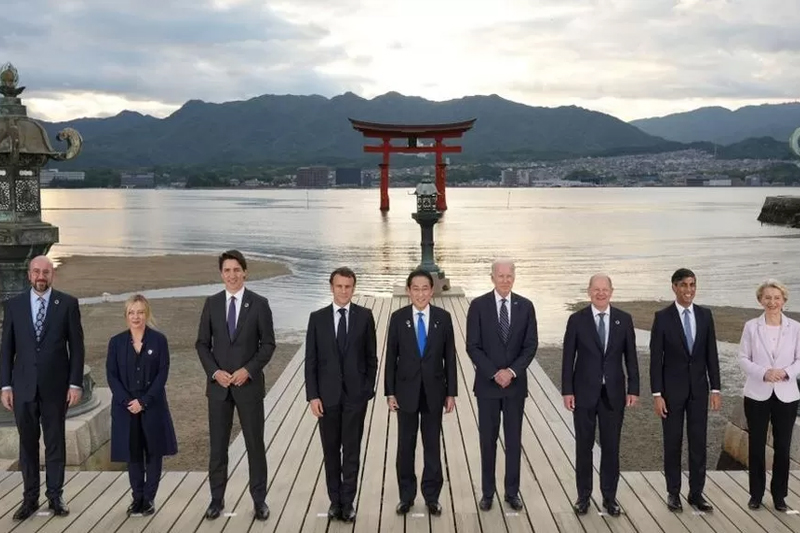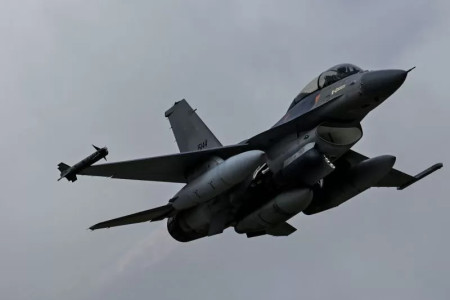National Security Adviser Jake Sullivan said President Joe Biden "informed his G7 counterparts" of the decision at the bloc's summit in Japan on Friday.
US troops will also train Kyiv's pilots to use the jets, Mr Sullivan said.
Ukraine has long sought advanced jets and President Volodymyr Zelensky hailed the move as a "historic decision".
The US legally has to approve the re-export of equipment purchased by allies and the move will clear the way for other nations to send their existing stocks of F-16s to Ukraine.
"Over the past few months, we and our allies and partners have really focussed on providing Ukraine with the systems weapon and training it needs to conduct offensive operations this spring and summer," Mr Sullivan told reporters in Hiroshima. "We have delivered what we promised."
"Now we have turned to discussions about improving the Ukrainian air force as part of our long-term commitment to Ukraine's self-defence. As the training unfolds in the coming months, we will work with our allies to determine when planes will be delivered, who will be delivering them, and how many."
Ukraine has repeatedly lobbied its Western allies to provide jets to help in its fight against Russia. Ahead of Saturday's official announcement, President Zelensky said the jets would "greatly enhance our army in the sky", adding that he looked forward to "discussing the practical implementation" of the plan at the G7 summit in Hiroshima, where he will arrive on Sunday.
The US had been sceptical about providing Ukraine with modern fighter jets - at least in the near term. Its focus has instead been on providing military support on land.
 Mr Zelensky is expected to join the G7 leaders in Japan
Mr Zelensky is expected to join the G7 leaders in Japan
Senior US military officials who have spoken to the BBC in the past have questioned whether Western-supplied fighter jets will dramatically alter the conflict, with Russia's large air force still struggling to gain air superiority and the high density of air defence systems on the ground.
And in February, President Biden told reporters that he was "ruling out for now" sending advanced fighters to Ukraine.
But Mr Sullivan told reporters that the US had provided weapons to Kyiv as they were needed on the battlefield, and the decision to start supplying advanced fighters to Ukraine indicated the conflict had entered a new phase.
"Now we have delivered everything we said we were going to deliver, so we put the Ukrainians in a position to make progress on the battlefield through the counteroffensive. We've reached a moment where it is time to look down the road, and say what is Ukraine going to need as part of a future force to defend against Russian aggression," he said.
Mr Sullivan also indicated the jets would only be used for defence purposes, adding the US would neither enable nor support attacks on Russian territory.
"The Ukrainians have consistently indicated that they are prepared to follow through on that," he said.
While the change in US policy is significant, training pilots to fly F-16 jets will take time. Ukraine does have more trained fighter pilots than aircraft at present. But even training experienced fighter pilots on a new plane could take up to four months.
And then nations will need to agree to supply the jets. The F-16 is widely used by a number of European and Middle East nations as well as the US, which still manufactures the aircraft. Who is willing to supply the jets is the next key question.
The UK, Netherlands, Belgium and Denmark also welcomed the US move.
UK Prime Minister Rishi Sunak tweeted: "The UK will work together with the USA and the Netherlands, Belgium and Denmark to get Ukraine the combat air capability it needs."
The UK does not have any F-16s in its air force itself.
Denmark has announced it too will now be able to support the training of pilots, but did not confirm whether it would send any jets to Ukraine. Denmark's air force has 40 F-16s, around 30 of which are operational.
Earlier this week, Mr Sunak and Dutch Prime Minister Mark Rutte said they would build an "international coalition" to provide fighter jet support for Ukraine.
Watch: Dogfights over Ukraine
Mr Sunak said the UK would set up a flight school to train Ukrainian pilots. French leader Emmanuel Macron said his country was willing to do the same but would not provide jets.
Some of the opposition to sending the jets has centred around maintenance issues, with former Nato official Dr Jamie Shea saying they require extensive maintenance after almost every fight.
Some Nato member countries have also expressed their worries that handing jets to Ukraine would be viewed as escalating the war, risking a direct confrontation with Russia.
What weapons are being supplied to Ukraine?
Duelling with Russian jets in the skies over Ukraine
At the start of Russia's full-scale invasion, Ukraine was believed to have around 120 combat capable aircraft - mainly consisting of aging Soviet-era MiG-29s and Su-27s.
But officials say they need up to 200 jets to match Moscow's air-power - which is thought to be five or six times greater than Kyiv's.
Mr Zelensky has primarily been asking its allies for F-16s. First built in the 1970s, the jet can travel at twice the speed of sound and can engage targets in the air or on the ground.
While now eclipsed by the more modern F-35, it remains widely in use. Experts say modern fighters like the F-16 would help Ukraine strike behind Russian lines.
Earlier this year some Eastern European countries sent Soviet-era Mig fighter jets to Ukraine.
Watch: Delivery of F-16 jets ‘hugely significant’ aid to Ukraine
By Jonathan Beale


